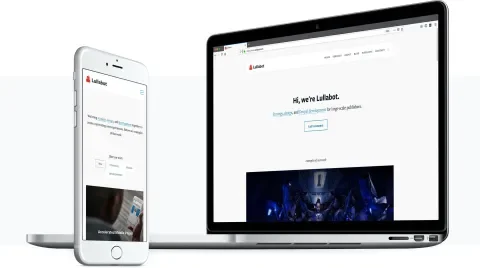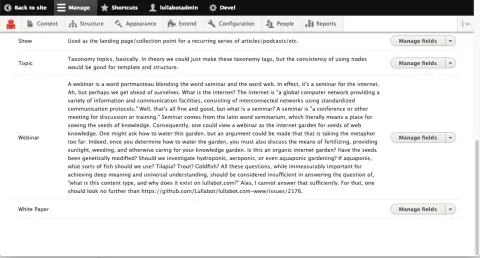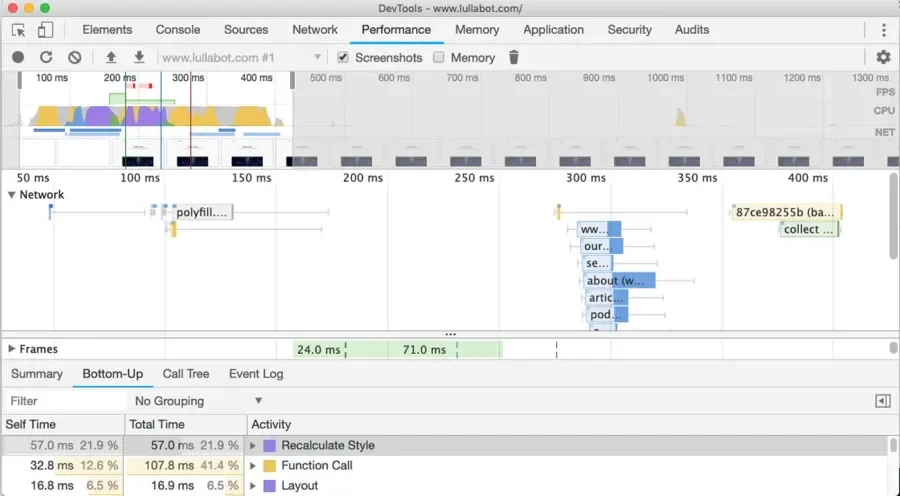Welcome to the latest version of Lullabot.com! Over the years (since 2006!), the site has gone through at least seven iterations, with the most recent launching last week at the 2019 Lullabot team retreat in Palm Springs, California.
Back to a more traditional Drupal architecture
Our previous version of the site was one of the first (and probably the first) decoupled Drupal ReactJS websites. It launched in 2015.
Decoupling the front end of Drupal gives many benefits including easier multi-channel publishing, independent upgrades, and less reliance on Drupal specialists. However, in our case, we don’t need multi-channel publishing, and we don’t lack Drupal expertise.
One of the downsides of a decoupled architecture is increased complexity. Building blocks of our decoupled architecture included a Drupal 7 back end, a CouchDB middle-layer, ReactJS front end, and Node.js server-side application. Contrast this with a standard Drupal architecture where we only need to support a single Drupal 8 site.
The complexity engendered by decoupling a Drupal site means developers take longer to contribute certain types of features and fixes to the site. In the end, that was the catalyst for the re-platforming. Our developers only work on the site between client projects so they need to be able to easily understand the overall architecture and quickly spin up copies of the site.
Highlights of the new site
In addition to easily swapping in and out developers, the primary goals of the website were ease of use for our non-technical marketing team (hi Ellie!), a slight redesign, and to maintain or improve overall site speed.
Quickly rolling developers on and off
To aid developers quickly rolling on and off the project, we chose a traditional Drupal architecture and utilized as little custom back-end code as possible. When we found holes in functionality, we wrote modules and contributed them back to the Drupal ecosystem.
We also standardized to Lando and created in-depth documentation on how to create a local environment.
Ease of use
To enable our marketing team to easily build landing pages, we implemented Drupal’s new experimental Layout Builder module. This enables a slick drag-and-drop interface to quickly compose and control layouts and content.
We also simplified Drupal’s content-entry forms by removing and reorganizing fields (making heavy use of the Field Group module), providing useful descriptions for fields and content types, and sub-theming the Seven theme to make minor styling adjustments where necessary.
Making the front end lean and fast
Normally, 80% of the delay between navigating to a webpage and being able to use the webpage is attributed to the front end. Browsers are optimized to quickly identify and pull in critical resources to render the page as soon as possible, but there are many enhancements that can be made to help it do so. To that end, we made a significant number of front-end performance optimizations to enable the rendering of the page in a half-second or less.
- Using vanilla JavaScript instead of a framework such as jQuery enables the JS bundle size to be less than 27kb uncompressed (to compare, the previous version’s bundle size was over 1MB). Byte for byte, JavaScript impacts the performance of a webpage more than any other type of asset.
- We heavily componentize our stylesheets and load them only when necessary. Combined with the use of lean, semantic HTML, the browser can quickly generate the render-tree—a critical precursor to laying out the content.
- We use HTTP2 to enable multiplexed downloads of assets while still keeping the number of HTTP requests low. Used with a CDN, this dramatically lowers the time-to-first-byte metric and time to download additional page assets.
- We heavily utilize resource-hints to tell the browser to download render-blocking resources first, as well as instructing the browser to connect third-party services immediately.
- We use the Quicklink module to pre-fetch linked pages when the browser is idle. This makes subsequent page loads nearly instantaneous.
There are still some performance @todos for us, including integrating WEBP images (now supported by Chrome and Firefox), and lazy-loading images.
Contributing modules back to the Drupal ecosystem
During the development, we aimed to make use of contributed modules whenever it made sense. This allowed us to implement almost all of the features we needed. Only a tiny fraction of our needs was not covered by existing modules. One of Lullabot’s core values is to Collaborate Openly which is why we decided to spend a bit more time on our solutions so we could share them with the rest of the community as contributed modules.
Using Layouts with Views
Layout Builder builds upon the concept of layout regions. These layout regions are defined in custom modules and enable editors to use layout builder to insert these regions, and then insert content into them.
Early on, we realized that the Views module lacked the ability to output content into these layouts. Lullabot’s Director of Technology, Karen Stevenson, created the Views Layout module to solve this issue. This module creates a new Views row plugin that enables the Drupal site builder to easily select the layout they want to use, and select which regions to populate within that layout.
Generating podcast feeds with Drupal 8
Drupal can generate RSS feeds out of the box, but podcast feeds are not supported. To get around this limitation, Senior Developer Mateu Aguiló Bosch created the Podcast module, which complies with podcast standards and iTunes requirements.
This module utilizes the Views interface to map your site’s custom Drupal fields to the necessary podcast and iTunes fields. For more information on this, checkout Mateu’s tutorial video here.
Speeding up Layout Builder’s user interface
As stated earlier, Layout Builder still has “experimental” status. One of the issues that we identified is that the settings tray can take a long time to appear when adding a block into the layout builder.
Lullabot Hawkeye Tenderwolf identified the bottleneck as the time it takes Drupal to iterate through the complete list of blocks in the system. To work around this, Karen Stevenson created the Block Blacklist module, in which you can specify which blocks to remove from loading. The result is a dramatically improved load time for the list of blocks.
Making subsequent page loads instantaneous
A newer pattern on the web (called the PRPL pattern) includes pre-fetching linked pages and storing them in a browser cache. As a result, subsequent page requests return almost instantly, making for an amazing user experience.
Bringing this pattern into Drupal, Senior Front-end Dev Mike Herchel created the Quicklink module using Google’s Quicklink JavaScript library. You can view the result of this by viewing this site’s network requests in your developer tool of choice.
Keeping users in sync using the Simple LDAP module
Lullabot stores employee credentials in an internal LDAP server. We want all the new hires to gain immediate access to as many services as possible, including Lullabot.com. To facilitate this, we use the Simple LDAP module (which several bots maintain) to keep our website in sync with our LDAP directory.
This iteration of Lullabot.com required the development of some new features and some performance improvements for the D8 version of the module.
Want to learn more?
- To learn more about the new Lullabot.com, listen to the latest Lullabot Podcast.
- Karen, Putra, Wes, and Ellie are speaking on Layout Builder in the Real World at DrupalCon Seattle. They’ll be talking about many of the improvements made on Lullabot.com, as well as Ellie’s thoughts on its user interface.
- Mike will be talking about web performance (including many of the enhancements made on this site) at Florida DrupalCamp, DrupalCamp London, DrupalCon Seattle’s Performance and Scalability Summit, as well as giving a 90-minute Front-end Web Performance Clinic at DrupalCon Seattle.
Built by Bots
While the site was definitely a team effort, special thanks go to Karen Stevenson, Mike Herchel, Wes Ruvalcaba, Putra Bonaccorsi, David Burns, Mateu Aguiló Bosch, James Sansbury, and, last but not least, Jared Ponchot for the beautiful designs.




